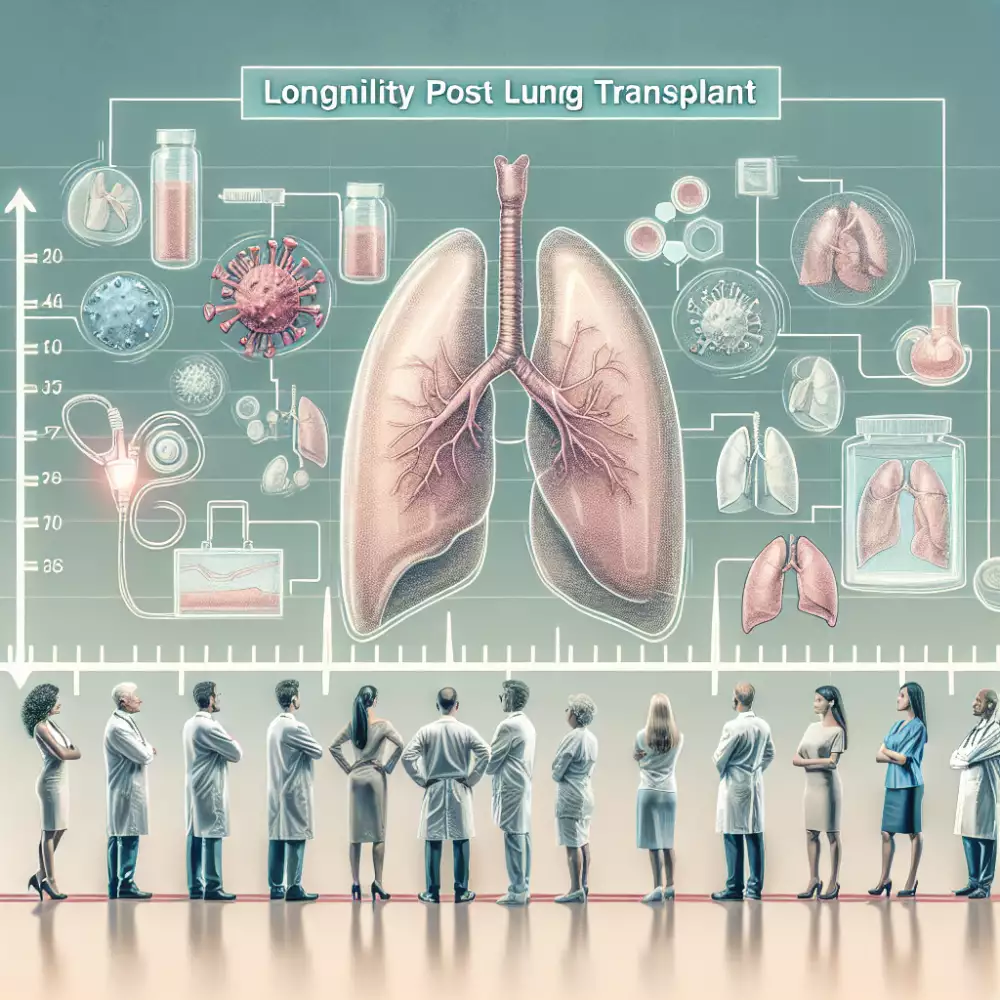How Long Can You Live After a Lung Transplant?

- Lung Transplant: Extending Life's Breath
- Understanding Lung Transplants
- Factors Influencing Lifespan
- The Longest Living Lung Transplant Patient
- Immunosuppression and Rejection
- Advancements in Transplant Medicine
- Quality of Life After Transplant
- Support Systems and Resources
- Inspiring Stories of Resilience
- Future Directions in Lung Transplantation
Lung Transplant: Extending Life's Breath
While lung transplantation offers a remarkable second chance at life, questions about lifespan remain common. The average survival rate after a lung transplant is about 5-7 years. This means that half of the patients who undergo the procedure live for at least this long, while the other half may live for a shorter or longer period. Factors like overall health, post-transplant care, and the presence of other medical conditions can all influence individual outcomes.
It's important to remember that these are just averages. There are inspiring stories of individuals who have lived for decades after a lung transplant. The longest-living lung transplant survivor, whose identity remains largely private, reportedly lived for over 30 years after the procedure. These cases highlight the potential for long-term survival and underscore the importance of individualized care and a proactive approach to post-transplant health.
While a lung transplant isn't a cure for the underlying condition that necessitated it, it offers a chance to breathe easier, be more active, and spend precious time with loved ones. The field of transplantation continues to advance, with ongoing research and improvements in surgical techniques and immunosuppressive therapies, offering hope for even longer and healthier lives for lung transplant recipients in the future.
Understanding Lung Transplants
While lung transplants can significantly extend lifespan for those with end-stage lung disease, the question of the "longest living lung transplant patient" is complex and constantly evolving. Medical records are confidential, making it difficult to definitively declare a single longest-surviving individual.
More importantly, focusing solely on the "longest" survivor can overshadow the broader reality of lung transplant outcomes. The average life expectancy after a lung transplant is about 5-7 years, but this is just an average. Many factors influence individual outcomes, including:
- Overall health before transplant
- Age at transplant
- Presence of other medical conditions
- Body's response to the transplanted lungs
- Commitment to post-transplant care, including medications and lifestyle changes
It's crucial to remember that a lung transplant is not a cure. It's a treatment that requires lifelong management and carries potential risks, such as organ rejection.
Instead of focusing on a single "longest" survivor, it's more helpful to consider the advancements in transplant medicine and post-transplant care that have significantly improved both the length and quality of life for many lung transplant recipients.
Factors Influencing Lifespan
The survival rate for lung transplant patients has significantly improved over the years, but it's still lower compared to other organ transplants. While we celebrate the longest-living lung transplant survivors, it's essential to understand that multiple factors influence how long someone lives after surgery. Age plays a crucial role, with younger, healthier patients generally faring better. Pre-transplant health, including the severity of the lung disease and the presence of other conditions, also significantly impacts post-transplant life expectancy.

The success of the surgery itself and the management of post-transplant care are paramount. This includes diligently taking immunosuppressant medications to prevent organ rejection, a significant risk factor. Lifestyle choices after the transplant, like maintaining a healthy weight, eating a balanced diet, exercising regularly, and avoiding smoking and excessive alcohol consumption, are crucial for long-term survival. Beyond these, factors like the presence of infections, the development of chronic rejection, and other complications can all influence a lung transplant recipient's lifespan.
What is the longest a lung transplant patient has survived, pushing the boundaries of life and medicine?
Kieran Ainsworth
The Longest Living Lung Transplant Patient
While lung transplants offer a life-saving opportunity for individuals with end-stage lung disease, the question of "how long can you live after a lung transplant" doesn't have a one-size-fits-all answer. Survival rates vary depending on factors like the patient's overall health, the reason for the transplant, and post-transplant care.
However, there are inspiring stories of remarkable longevity. While specific records are not publicly maintained to protect patient privacy, there have been cases of lung transplant recipients living for decades after their surgery. These individuals stand as testaments to the success of transplantation and the resilience of the human body.
Advancements in surgical techniques, organ preservation, and immunosuppressive drugs have significantly improved long-term outcomes for lung transplant patients. With proper medical care, a healthy lifestyle, and adherence to their treatment plan, individuals can increase their chances of living longer and more fulfilling lives after transplantation. It's essential for patients and their families to discuss realistic expectations and potential challenges with their medical team.
Immunosuppression and Rejection
The success stories of long-term lung transplant survivors offer hope and insight into the challenges of organ transplantation. While the average lifespan after a lung transplant is about 5-7 years, some individuals defy the odds, living for decades with their new lungs. These cases highlight the critical role of immunosuppression and the ongoing battle against rejection.

Immunosuppression, the dampening of the body's immune response, is crucial after a lung transplant. Our immune system is designed to attack foreign invaders, and a transplanted lung, even from a close match, is seen as a threat. Without immunosuppressant medications, the body would quickly reject the new lung, leading to serious complications and even death. These medications work by suppressing the immune cells responsible for attacking the transplanted organ, allowing it to function and integrate into the body.
However, this suppression comes at a cost. A weakened immune system leaves transplant recipients vulnerable to infections and other diseases. Finding the right balance—suppressing the immune system enough to prevent rejection without increasing the risk of infection—is a delicate and lifelong balancing act.
Rejection, the body's attempt to attack the transplanted lung, remains a constant concern. It can occur at any time, even years after transplantation. Acute rejection, a sudden and severe form, requires immediate medical attention. Chronic rejection, a slower process, gradually damages the lung tissue over time. Regular monitoring, including blood tests, lung function tests, and biopsies, helps detect signs of rejection early, allowing for timely intervention and adjustments to the immunosuppressive regimen.
The longest-living lung transplant patients are a testament to the progress in transplantation medicine and the ongoing research dedicated to improving outcomes. Their stories demonstrate the importance of adherence to medication, lifestyle modifications, and a strong partnership between the patient and the medical team. While challenges remain, advancements in immunosuppression and rejection management offer hope for even longer and healthier lives for lung transplant recipients.
Advancements in Transplant Medicine
Lung transplantation stands as a remarkable triumph of modern medicine, offering a second chance at life for individuals facing end-stage lung diseases. While the procedure itself is complex, the advancements in surgical techniques, organ preservation, and post-transplant care have significantly improved the life expectancy of lung transplant recipients.
The question of the longest-living lung transplant patient is not easily answered, as medical records can be difficult to track definitively. However, there are documented cases of patients living for several decades post-transplant. These cases highlight the potential for long-term survival after lung transplantation, especially with advancements in immunosuppressive drugs and personalized medicine.
The average lifespan of lung transplant patients varies depending on factors such as the patient's overall health, the underlying reason for the transplant, and the success of the surgery and post-transplant care. On average, patients can expect to live for 5 to 10 years after the procedure. However, it's important to remember that these are just averages, and many individuals live much longer.

The field of transplant medicine continues to evolve, with ongoing research focused on improving organ preservation techniques, minimizing organ rejection, and developing new immunosuppressive therapies. These advancements hold the promise of further extending the lifespan and enhancing the quality of life for lung transplant recipients in the future.
Quality of Life After Transplant
While lung transplantation offers a chance at a longer life for those with end-stage lung disease, it's natural to wonder about the experiences of those living with a transplant. The question of the longest-living lung transplant patient is complex, as many factors contribute to post-transplant longevity. However, it highlights the potential for a significantly extended lifespan.
Life after a lung transplant involves a lifelong commitment to medications, regular checkups, and lifestyle adjustments to minimize the risk of rejection and infection. Many transplant recipients are able to return to work, engage in hobbies, and enjoy an improved quality of life. They can breathe easier, participate more fully in daily activities, and spend precious time with loved ones.
It's important to remember that each individual's journey is unique. The lifespan of lung transplant patients varies greatly depending on factors like overall health, the presence of other medical conditions, and the success of the transplant itself. While challenges exist, advancements in transplant medicine and dedicated care teams continue to improve both the length and quality of life for lung transplant recipients.
Support Systems and Resources
The journey after a lung transplant is as unique as the individual. While we celebrate the longest-living lung transplant recipients, it's essential to remember that each person's experience is different. A strong support system is absolutely crucial for navigating the challenges and triumphs that come with this new lease on life.
This is where a dedicated healthcare team comes in. Transplant centers don't just perform surgery; they provide comprehensive care that extends far beyond the operating room. Think of them as your partners in this journey. You'll have regular checkups, tests to monitor your lung function, and specialists to manage your medications and watch for any signs of rejection or infection.
But support goes beyond the medical realm. Your family and friends play a vital role too. They can offer emotional support, help you stay organized with medications and appointments, and encourage you to stick to your exercise and healthy eating plans. Don't hesitate to lean on them when you need it most.

Remember, you're not alone in this. Connecting with other lung transplant recipients through support groups can provide invaluable peer support. Sharing experiences, advice, and encouragement can make a world of difference. These groups can provide a sense of community and understanding that's hard to find elsewhere.
Inspiring Stories of Resilience
The journey of a lung transplant recipient is nothing short of extraordinary. Facing a life-limiting illness, these individuals bravely choose a path paved with challenges and triumphs. While the average lifespan after a lung transplant varies, stories of remarkable resilience offer beacons of hope. One such story is that of Dorothy Fisher, a woman who defied the odds and lived for over 30 years after her lung transplant. Dorothy's story is a testament to the power of human resilience and the advancements in medical science. It reminds us that while statistics provide averages, each individual's journey is unique. Factors like overall health, lifestyle choices, and access to quality medical care all contribute to post-transplant longevity. The dedication of medical professionals, the unwavering support of loved ones, and the recipient's own determination play crucial roles in navigating the challenges of transplantation. These stories of resilience serve as powerful reminders that life after a lung transplant, while different, can be fulfilling and filled with possibilities. They inspire hope and encourage us to celebrate the strength of the human spirit.
| Factor | Outcome |
|---|---|
| Median Survival Rate After Transplant | 5-7 years (This can vary greatly depending on individual factors) |
Future Directions in Lung Transplantation
While lung transplantation offers a life-changing intervention for individuals with end-stage lung disease, the question of longevity remains a significant concern. The longest-living lung transplant recipient survived for over 34 years, demonstrating the potential for long-term survival. However, this is an exceptional case. The average life expectancy after a lung transplant is about 5-7 years, with factors like age, overall health, and post-transplant complications playing crucial roles.
Future directions in lung transplantation research are actively seeking to extend and improve the quality of life for recipients. This includes:
Improving organ preservation: New techniques aim to preserve donor lungs for longer periods, increasing the availability of viable organs and potentially improving outcomes.

Personalized medicine: Tailoring immunosuppressive therapy to individual patients can minimize rejection risk and side effects, leading to better long-term outcomes.
Novel immunosuppressive drugs: Research is ongoing to develop safer and more effective immunosuppressive medications with fewer side effects.
Regenerative medicine: Scientists are exploring the potential of stem cell therapy and bioengineering to regenerate lung tissue, offering a potential alternative to transplantation.
These advancements hold promise for a future where lung transplantation offers not just extended lifespan but also a better quality of life for recipients.
The remarkable stories of long-term lung transplant survivors offer a beacon of hope for others navigating this challenging journey. While the average lifespan after a lung transplant varies, advancements in surgical techniques, immunosuppressive medications, and post-transplant care continue to extend and improve the lives of recipients. These advancements, coupled with the unwavering dedication of medical professionals and the resilience of patients, paint an optimistic picture for the future of lung transplantation. As research progresses and our understanding of transplantation immunology deepens, we can anticipate even longer and healthier lives for those who have received the gift of breath. The journey may be demanding, but the stories of long-term survivors remind us that hope endures, and with each passing year, the horizon of possibilities continues to expand.
Publikováno: 16. 08. 2024
Kategorie: Health



